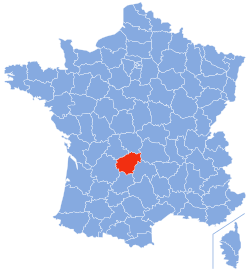Corrèze
Department of France in Nouvelle-Aquitaine From Wikipedia, the free encyclopedia
Department of France in Nouvelle-Aquitaine From Wikipedia, the free encyclopedia
Corrèze (French pronunciation: [kɔʁɛz] ; Occitan: Corresa) is a département in France, named after the river Corrèze which runs through it. Although its prefecture is Tulle, its most populated city is Brive-la-Gaillarde. Corrèze is located in the Nouvelle-Aquitaine region, on the border with Occitania and Auvergne-Rhône-Alpes.
Corrèze
| |
|---|---|
 Prefecture building in Tulle | |
 Location of Corrèze in France | |
| Coordinates: 45°20′N 1°50′E | |
| Country | France |
| Region | Nouvelle-Aquitaine |
| Prefecture | Tulle |
| Subprefectures | Brive-la-Gaillarde Ussel |
| Government | |
| • President of the Departmental Council | Pascal Coste[1] (LR) |
| Area | |
| • Total | 5,857 km2 (2,261 sq mi) |
| Population (2021)[2] | |
| • Total | 239,784 |
| • Rank | 84th |
| • Density | 41/km2 (110/sq mi) |
| Time zone | UTC+1 (CET) |
| • Summer (DST) | UTC+2 (CEST) |
| ISO 3166 code | FR-19 |
| Department number | 19 |
| Largest city | Brive-la-Gaillarde |
| Arrondissements | 3 |
| Cantons | 19 |
| Communes | 279 |
| ^1 French Land Register data, which exclude estuaries and lakes, ponds and glaciers larger than 1 km2 | |
In 2019, Corrèze had a population of 240,073,[3] divided among 279 communes. Its inhabitants are called Corréziens (masculine) and Corréziennes (feminine). Its INSEE and postal code is 19.
The department makes up of most of Lower Limousin and owes its name to the Corrèze river whose entire course flows through the centre, and passes through the two main cities, Tulle and Brive-la-Gaillarde. Tulle is the prefecture of Corrèze, and Brive-la-Gaillarde the largest city.
Since 2015, the department is administered by the Nouvelle-Aquitaine region. To the north, it borders the departments of Haute-Vienne and the Creuse, to the east, the departments of Puy-de-Dôme and Cantal, to the south of that of the Lot and, finally, to the west of that of the Dordogne.
Located west of the Massif Central, it consists of three zones: the Mountains (Montagne), the plateaus and the Brive Basin.
The mountains' peak at 977 m at Mount Bessou. Its Rhenohercynian Zone formation is quite eroded.
The plateaus have deep valleys that head towards the Dordogne river, such as at the Gimel waterfalls.
South-west of Corrèze, the Brive sedimentary basin enjoys a more favourable climate. There are sandstone hills like Collonges-la-Rouge.
The department is crossed by several rivers, such as Vézère, Corrèze or the Dordogne.
The department transitions between the Aquitaine and the Massif Central, the Corrèze department sees its elevation gradually rise from the basin of Brive to the Plateau de Millevaches, watershed of the Atlantic facade. This relief explains the wide variety of climates of Corrèze.
The most populous commune is Brive-la-Gaillarde; the prefecture Tulle is the second-most populous. As of 2019, there are 7 communes with more than 4,000 inhabitants:[3]
| Commune | Population (2019) |
|---|---|
| Brive-la-Gaillarde | 46,330 |
| Tulle | 14,812 |
| Ussel | 9,358 |
| Malemort | 7,984 |
| Saint-Pantaléon-de-Larche | 4,751 |
| Égletons | 4,295 |
| Ussac | 4,215 |
Corrèze is one of the original 83 departments created during the French Revolution on 4 March 1790. It includes part of the former province of Limousin (the Bas-Limousin).
Within Corrèze the nineteenth-century railway planners, influenced in part by the department's topography, endowed Brive-la-Gaillarde with good connections and a major junction from which railway lines fanned out in six different directions. The railways arrived in 1860, at an opportune moment, directly after phylloxera had destroyed the local wine industry. The new railways enabled the farms in the area surrounding Brive to specialise in fruits and vegetables which they could now transport rapidly to the larger population centres of central and southern France. Locally, the new agriculture triggered the development, in the Brive basin, of related businesses and industries such as the manufacture of jams and liquors, as well as timber/paper-based packaging businesses.
The 1851 census recorded a population of 320,866: this remained relatively constant for the rest of the nineteenth century. During the twentieth century, however, Corrèze shared the experience of many of the country's rural departments as the population fell steadily.
|
| |||||||||||||||||||||||||||||||||||||||||||||||||||||||||||||||||||||||||||||||||||||||
| ||||||||||||||||||||||||||||||||||||||||||||||||||||||||||||||||||||||||||||||||||||||||
| Sources:[4][5] | ||||||||||||||||||||||||||||||||||||||||||||||||||||||||||||||||||||||||||||||||||||||||
The President of the General Council was François Hollande of the Socialist Party until 2012 when he was elected President of the Republic. Jacques Chirac also served as a Deputy of the National Assembly from here for many years.
| Party | seats | |
|---|---|---|
| Union for a Popular Movement | 18 | |
| • | Socialist Party | 16 |
| • | French Communist Party | 2 |
| • | Miscellaneous Left | 1 |
People who were born or have significantly lived in Corrèze include:
Seamless Wikipedia browsing. On steroids.
Every time you click a link to Wikipedia, Wiktionary or Wikiquote in your browser's search results, it will show the modern Wikiwand interface.
Wikiwand extension is a five stars, simple, with minimum permission required to keep your browsing private, safe and transparent.